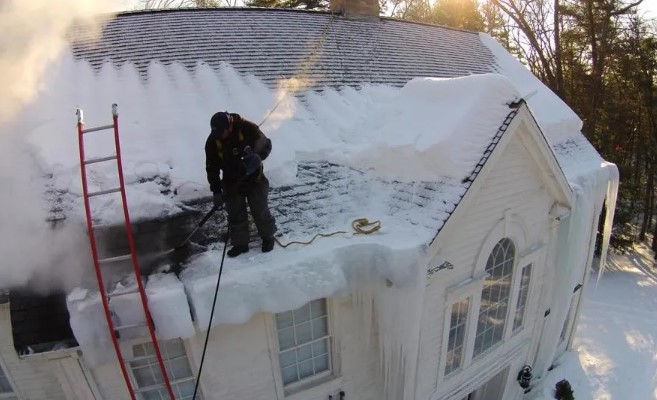Business News and FOMC Meeting: Live Updates


Algeria has stopped supplying gas through one of its main pipelines that crosses Morocco, a move that could threaten Spain with reduced supplies or higher prices for natural gas as winter approaches and energy costs are soaring.
The shutdown, which began Monday, is the result of a longstanding territorial feud between Morocco and Algeria. It is meant to deprive Morocco of natural gas, which generates about 10 percent of the country’s electricity, as well as tens of millions of dollars of transit fees paid by users of the pipeline.
But it may also have a heavy impact on Spain, which imports about half of its gas from Algeria. Spaniards, like others throughout Europe, have been struggling with higher electrical bills because of a surge in the price of natural gas. The government in Madrid has had to take emergency measures to soften the blow on consumers.
The pipeline, with a capacity of about 13 billion cubic meters a year, is not the only way for Algerian gas to reach Spain. A smaller undersea pipeline that links Algeria and southern Spain can carry about eight billion cubic meters a year, and Sonatrach, the Algerian national energy company, recently said that it hoped to increase its output to 10.5 billion cubic meters by the end of November.
Algeria is also proposing to make up for Spain’s lost gas by chartering tankers to transport liquefied natural gas across the Mediterranean, even as the cost of such shipments has surged recently.
This week’s move by the Algerian government comes after it broke off diplomatic relations with Morocco in August, in part to protest Morocco’s efforts to control the Western Sahara, a disputed territory. Since then Algeria has also closed off its airspace to Moroccan aircraft.
The dispute was rekindled last year when the Polisario Front, a Western Sahara separatist group backed by Algeria, broke off a longstanding cease-fire with Morocco.
On Sunday the Algerian government said that Sonatrach would end its commercial activities with Morocco because that country’s “hostile” actions threatened “the national unity” of Algeria.
Morocco said the gas shut-off would have an “insignificant” impact on its electricity network. Morocco had been using Algerian gas to power two electricity plants that are partly operated by Spanish companies.
After an emergency meeting in Algiers last week, Spain’s environment and energy minister, Teresa Ribera, said that she was confident that Algeria could “guarantee that everything works in the most fluid and best manner possible” to keep gas supply flowing to Spain.
Some analysts are warning that it will be a challenge for Algeria to raise the capacity of the undersea pipeline or charter more liquefied natural gas ships, given that there is a shortage of available vessels.
Gonzalo Escribano, an energy expert at the Real Instituto Elcano, a Madrid-based think tank, said that Algeria’s pipeline closing could result in Spain paying more for the gas, given the high cost and complicated logistics of shipping liquefied natural gas, but it should not pose a major supply risk ahead of the winter. Despite the latest tensions, he said, “Algeria has historically always honored its contracts and political pledges in this field.”
For Morocco, however, Mr. Escribano said, “the situation is much more complicated,” both in terms of losing Algerian gas that had fueled its electricity grid and losing the fees that it had received from the gas transiting through the pipeline.
The Federal Reserve’s November policy statement, which will be released on Wednesday afternoon, is expected to include plenty of news about the central bank’s short-term plans to scale back its purchases of government-backed bonds. Yet Wall Street is most acutely focused on what comes next.
Jerome H. Powell, the Fed chair, and his fellow policymakers are expected to announce a plan to slow their $120 billion in monthly asset purchases, which they had been using to support the economy during the pandemic. But with inflation at a three-decade high, investors are eager to hear how worried officials are about prices, and to glean what that might mean for the future of the Fed’s other monetary tool, its policy interest rate.
The Fed’s main rate is its more traditional and more powerful monetary lever, and it has been set to near zero since March 2020. While policymakers are set to leave it at rock bottom this week, other central banks around the world are moving toward rate increases as supply chain snarls and labor shortages help to fuel inflation. Economists and investors increasingly expect that America’s central bank will follow suit next year.
When and how quickly the Fed might lift borrowing costs is important for the economy, because higher rates would cool down growth by slowing borrowing and spending, weighing on business investment and home buying and weakening the job market.
Here’s what to watch for from the Fed.
-
The Fed’s statement. The policy-setting Federal Open Market Committee will release its statement at 2 p.m. and the central bank is widely expected to announce its plans to taper off bond purchases.
Investors will also look for an update to the Fed’s discussion about inflation. In its September policy statement, the Fed said “inflation is elevated, largely reflecting transitory factors.” The central bank noted that prices had previously run persistently below the Fed’s goal, language that suggested high prices were not a long-term threat.
-
Mr. Powell’s price forecast. The Fed chair has been clear that he thinks it is time to scale back its bond purchases but not to raise interest rates, and that the pace at which the Fed tapers is not meant to signal when borrowing costs are going to move up. But he and his colleagues have also sounded increasingly worried about price increases, which they had previously argued would be “transitory.” While Mr. Powell is likely to maintain that rapid price increases should fade as the economy normalizes, he will probably also stress the uncertainty around that forecast.
-
Mr. Powell’s take on inflation expectations. Fed officials had pointed to inflation expectations as an encouraging sign that consumers and businesses expected price gains to simmer down with time. But several price outlook gauges have now moved higher. Most are still at historically normal levels, but the continuing increases are sure to catch policymakers’ attention.
-
Mr. Powell’s thoughts about the inflation and jobs trade-off. The Fed is trying to avoid raising rates quickly in response to today’s hot inflation, worried that it will cool off the economy just as supply chains begin to right themselves and booming demand for goods fades — a cocktail what would naturally bring inflation back down. That could unnecessarily slow the economy, weakening hiring at time when millions of jobs remain missing compared with before the pandemic. After all, the Fed has two goals: stable prices and full employment.
-
The global context. High inflation isn’t a problem made in America. Prices are surging across many wealthy nations. The Bank of England could become the first major central bank to lift interest rates when it meets on Thursday. The Reserve Bank of Australia has ditched part of its economy-stoking monetary policy, and the Bank of Canada is walking back its own stimulus package.
-
The politics. President Biden’s White House studiously avoids commenting on Fed policy in deference to the central bank’s independence. But this is a high-stakes meeting for Mr. Powell. It could well be the last one before the administration announces whether it will keep him or replace him at the central bank’s helm after his term ends early in 2022. Some commentators expect the administration will want a Fed chair who favors growth-friendly policies, but it is also the case that the White House is focused on inflation. Mr. Biden himself has demurred when asked about his criteria and whether he has made a decision yet.
“I’m not going discuss it with you because that’s in train now, we’ll be making those announcements fairly quickly,” Mr. Biden said during a news conference Tuesday when asked about Mr. Powell’s potential renomination.
Zillow, the real estate website known for estimating house values, said on Tuesday that it would exit the business of rapidly buying and selling houses amid heavy losses and that it planned to let go about nearly 25 percent of its employees.
The announcement was a major strategic retreat and a black eye for Richard Barton, Zillow’s chief executive, who founded the company 16 years ago and has long talked about transitioning Zillow’s popular website into a marketplace. Last year, Mr. Barton predicted Zillow Offers, which made instant offers on homes in a practice known as iBuying, could generate $20 billion a year.
On Tuesday, Zillow, which said it has 8,000 employees, said the division had been the source of huge losses and had made the company’s overall bottom line unpredictable. Zillow Offers lost more than $420 million in the three months ending in September, roughly the same amount that the company had earned in total during the prior 12 months.
“We’ve determined the unpredictability in forecasting home prices far exceeds what we anticipated,” Mr. Barton said in a statement accompanying its quarterly financials.
Mr. Barton, speaking on a conference call with analysts on Tuesday afternoon, said the decision had “weighed heavily” on him. “We could blame the current losses on exogenous market events,” Mr. Barton said. “But it would be naïve to predict that unpredictable events won’t happen in the future.”
In all the company lost nearly $330 million in the third quarter, which was far worse than Wall Street analysts had predicted. The company made a $40 million profit in the same period a year ago.
Shares of Zillow have fallen more than 50 percent from a high of nearly $200 in February, when it was still a darling of investors as the housing market heated up. The stock dropped 11.5 percent on Tuesday to about $85.50 before it released its financials, and a further 7.5 percent in after-hours trading. (Even so, Zillow’s shares are worth double what they were at the beginning of the pandemic.)
Three years ago, the company announced plans to employ its pricing estimates to buy and sell houses. Now, Zillow is sitting on thousands of houses worth less than what the company paid for them. Last month, Zillow announced it would temporarily stop buying new homes. At the time, it blamed a lack of workers to fix up and sell the houses it had bought. But on Tuesday, Mr. Barton said using its algorithm to buy and sell houses had not produced predictable profits. It is now looking to offload its remaining 7,000 houses.
It appears the company underestimated the risk of holding houses in between transactions, which was a departure from the low-risk, high-margin ad business. And it tried to quickly ramp up its home-flipping business to 5,000 transactions a month, which Mr. Barton set as a goal, in a housing market that was already low on inventory and was starting to cool off.
Zillow’s stumble also raises questions about its core product, which is built around its value estimates. Aaron Edelheit, who began buying houses in the wake of the Great Recession, tweeted his thanks to Zillow for paying “such an extremely high price” for one of his properties this summer. “It appeared they were panic buying,” Mr. Edelheit, who is leaving the real estate market to focus on cannabis, told The New York Times’s DealBook newsletter. “I didn’t get it. I should have shorted the stock.”
For the second time in under one month, workers at the agriculture equipment maker Deere & Company rejected a contract proposal negotiated by their union on Tuesday, extending a strike that began in mid-October.
Roughly 10,000 workers, primarily at plants in Iowa and Illinois, on Oct. 10 voted down an earlier agreement negotiated by the United Automobile Workers union.
“The strike against John Deere & Company will continue as we discuss next steps with the company,” the union said in a statement.
Marc A. Howze, a senior Deere official, said in a statement that the agreement would have included an investment of “an additional $3.5 billion in our employees, and by extension, our communities.”
“With the rejection of the agreement covering our Midwest facilities, we will execute the next phase of our Customer Service Continuation Plan,” the statement continued, alluding to its use of salaried employees to run facilities where workers are striking.
Many workers had complained that wage increases and retirement benefits included in the initial proposal were too weak given that the company — known for its distinctive green-and-yellow John Deere products — was on pace for a record of nearly $6 billion in annual profits.
According to a summary produced by the union, wage increases under the more recent proposal would have been 10 percent this year and 5 percent in the third and fifth years. During each of the even years of the six-year contract, employees would have received a lump-sum payment equivalent to 3 percent of their annual pay.
That was up from earlier proposed wage increases of 5 or 6 percent this year, depending on a worker’s labor grade, and 3 percent in 2023 and 2025.
The more recent proposal also included traditional pension benefits for future employees and a post-retirement health care fund seeded by $2,000 per year of service, neither of which were included in the initial agreement.
Chris Laursen, a worker at a John Deere plant in Ottumwa, Iowa, who was president of his local there until recently, said he voted in favor of the new agreement after voting to reject the previous one.
“We have the support of the community, we have the support of workers all around the country,” Mr. Laursen said. “If we turned down a 20 percent increase over a six-year period, substantial gains to our pension plan, I’m afraid we would lose that.”
But Mr. Laursen said he still had concerns about the vagueness of the company’s commitment to improving its worker incentive plan, and such concerns appeared to weigh on his co-workers, 55 percent of whom voted to reject the newer contract.
One wrinkle complicating the vote was suspicion among rank-and-file workers toward the union leadership related to a series of corruption scandals, which have led to more than 15 convictions, including two recent U.A.W. presidents.
The work stoppage at Deere was part of an uptick in strikes around the country last month that also included more than 1,000 workers at Kellogg and more than 2,000 hospital workers in upstate New York.
Overall, more than 25,000 workers walked off the job in October, versus an average of about 10,000 in each of the previous three months, according to data collected by researchers at Cornell University.


/cloudfront-us-east-1.images.arcpublishing.com/dmn/O2J5Z4GLWVJNII37X5C2376ZPM.jpg)




